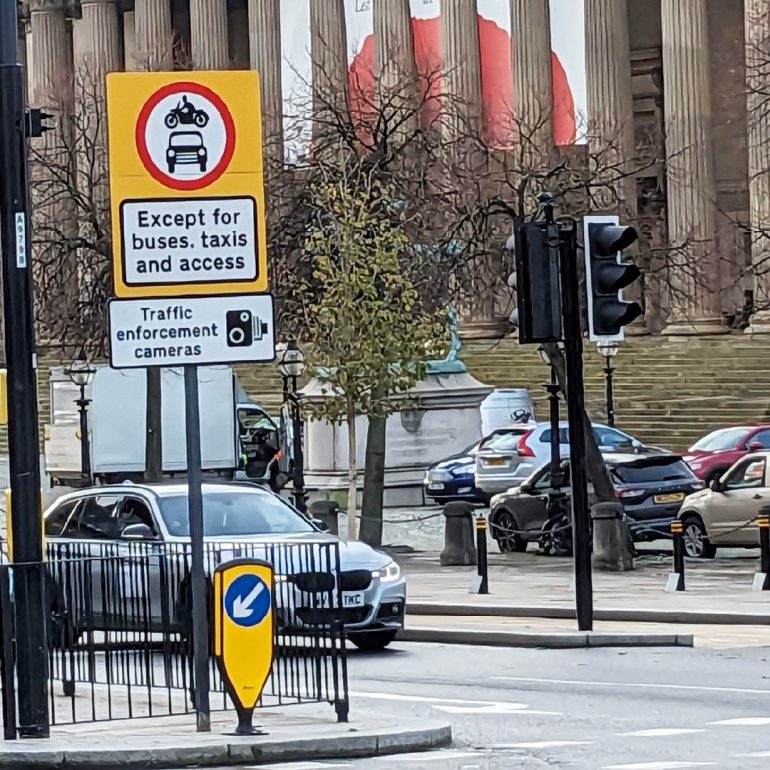First-time offenders will now be given a fine, instead of a written warning, at a number of new traffic enforcement locations after a six-month notice period ended.
A series of “reg plate cameras” designed to curb moving traffic contraventions went live in Liverpool earlier this year, with motorists receiving a letter instead of a £70 fine for their first offence.
The warning notice period ended at the start of this week for the majority of locations, with Liverpool City Council issuing approximately 40,000 warnings and close to 3,000 fines to repeat offenders during that time.
The City Council installed Automatic Number Plate Recognition (ANPR) cameras as part of new enforcement powers granted by the Department of Transport to tackle unlawful and dangerous driving behaviour and to help reduce congestion, improve air quality and road safety, and encourage sustainable travel.
The new powers, as set out in Part 6 of the Traffic Management Act (2004), allows local authorities to penalise poor driving habits which previously could only be enforced by the police, under criminal law.
The new ANPR cameras, which went live at the start of Road Safety Week, will also complement changes to key parts of the city’s highways networks such as the upgrade of The Strand and Lime Street, and the increasing number of cycle lanes being introduced across the city.
Examples of the type of moving traffic offences that can be enforced under the new powers include:
- Undertaking banned turns
- Driving through a ‘No Entry’ sign
- Driving in a route permitted for buses and taxis only
- Driving through a school street, pedestrian and cycle zone
- Entering a yellow box junction when the exit is not clear
Liverpool’s ANPR cameras are situated at:
- Lime Street from London Road – no motor vehicles, except for buses, taxis and access
- Lime Street bus link – between Skelhorne Street and St George’s Place – no entry for private vehicles on bus-only route.
- Copperas Hill at Ranelagh Place – failure to follow left-turn only sign
- Ranelagh Street at Brownlow Hill – no u-turn on Ranelagh Place
- Whitechapel Cross/Hall Street junction – no entering and stopping on box junction when exit is not clear
- The Strand at New Quay/Chapel Street (southbound) – no entering and stopping on box junction
- St Anne Street (opposite the Fire Station) – no entering and stopping on box junction
A new camera has also gone live this month on The Strand at George’s Dock Gates/St Nicholas Place – no entering and stopping on box junction – with the warning notice period to end in February 2025.
As well as the above, the existing bus gate on Ranelagh Street also benefits from ANPR cameras.
Two ‘school streets’ (for Greenbank Primary School and Much Woolton Primary School) also have APNR cameras, at Arlington Avenue from Greenbank Road and Arlington Avenue from Nicander Road; Watergate Lane from Woodrock Road and Watergate Way from Priorsfield Road.
These ANPR cameras are only operation during school term times.
Councillor Dan Barrington, Cabinet Member for Environment and Climate Change, said: “Road Safety is of paramount importance to the Council. These new powers to enforce moving traffic contraventions are a key part of a wider programme to improve road safety across the city.
“These new APNR cameras are enabling us to enforce the Highway Code and improve behaviours at key junctions, in both the city centre and near to our schools.
“Our overall aim is to educate people to be more patient behind the wheel, and ideally encourage people to think twice about using the car at all. Most car journeys in the city are under 5km, many of which could be done by alternative methods.
“That’s why as a Council we’re supporting moves to improve public transport and why we’re investing millions of pounds in active travel infrastructure to make it easier and safer to walk and cycle more often.”


